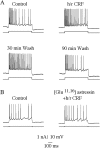Corticotropin-releasing factor receptors couple to multiple G-proteins to activate diverse intracellular signaling pathways in mouse hippocampus: role in neuronal excitability and associative learning
- PMID: 12533630
- PMCID: PMC6741896
- DOI: 10.1523/JNEUROSCI.23-02-00700.2003
Corticotropin-releasing factor receptors couple to multiple G-proteins to activate diverse intracellular signaling pathways in mouse hippocampus: role in neuronal excitability and associative learning
Abstract
Corticotropin-releasing factor (CRF) exerts a key neuroregulatory control on stress responses in various regions of the mammalian brain, including the hippocampus. Using hippocampal slices, extracts, and whole animals, we investigated the effects of human/rat CRF (h/rCRF) on hippocampal neuronal excitability and hippocampus-dependent learning in two mouse inbred strains, BALB/c and C57BL/6N. Intracellular recordings from slices revealed that application of h/rCRF increased the neuronal activity in both mouse inbred strains. Inhibition of protein kinase C (PKC) by bisindolylmaleimide I (BIS-I) prevented the h/rCRF effect only in hippocampal slices from BALB/c mice but not in slices from C57BL/6N mice. Inhibition of cAMP-dependent protein kinase (PKA) by H-89 abolished the h/rCRF effect in slices from C57BL/6N mice, with no effect in slices from BALB/c mice. Accordingly, h/rCRF elevated PKA activity in hippocampal slices from C57BL/6N mice but increased only PKC activity in the hippocampus of BALB/c mice. These differences in h/rCRF signal transduction were also observed in hippocampal membrane suspensions from both mouse strains. In BALB/c mice, hippocampal CRF receptors coupled to G(q/11) during stimulation by h/rCRF, whereas they coupled to G(s), G(q/11), and G(i) in C57BL/6N mice. As expected on the basis of the slice experiments, h/rCRF improved context-dependent fear conditioning of BALB/c mice in behavioral experiments, and BIS-I prevented this effect. However, although h/rCRF increased neuronal spiking in slices from C57BL/6N mice, it did not enhance conditioned fear. These results indicate that the CRF system activates different intracellular signaling pathways in mouse hippocampus and may have distinct effects on associative learning depending on the mouse strain investigated.
Figures






References
-
- Aldenhoff JB, Gruol DL, Rivier J, Vale W, Siggins GR. Corticotropin releasing factor decreases postburst hyperpolarizations and excites hippocampal neurons. Science. 1983;221:875–877. - PubMed
-
- Anisman H, Hayley S, Kelly O, Borowski T, Merali Z. Psychogenic, neurogenic, and systemic stressor effects on plasma corticosterone and behavior: mouse strain-dependent outcomes. Behav Neurosci. 2001;115:443–454. - PubMed
-
- Battaglia G, Webster EL, De Souza EB. Characterization of corticotropin-releasing factor receptor-mediated adenylate cyclase activity in the rat central nervous system. Synapse. 1987;1:572–581. - PubMed
-
- Beuzen A, Belzung C. Link between emotional memory and anxiety states: a study by principal component analysis. Physiol Behav. 1995;58:111–118. - PubMed
-
- Blanchard RJ, Blanchard DC. Passive and active reactions to fear-eliciting stimuli. J Comp Physiol Psychol. 1969;68:129–135. - PubMed
Publication types
MeSH terms
Substances
Grants and funding
LinkOut - more resources
Full Text Sources
Research Materials
Miscellaneous
